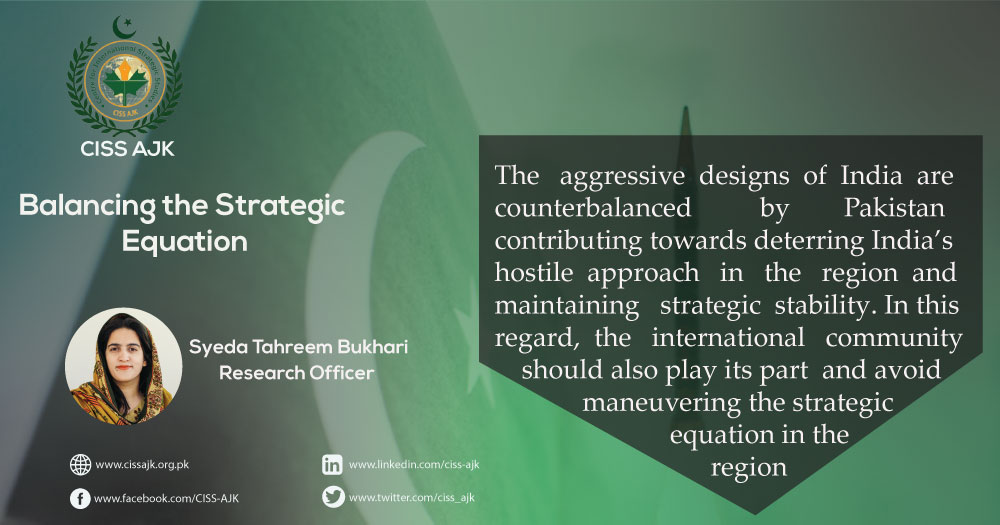779
Pakistan was facing existential threats from India soon after its inception. As a result of India’s hegemonic regional designs since 1947, Islamabad’s countermeasures were dictated by the same Indian aggressive behaviour. It was countering India’s aggression through internal and external balancing. India tugged Pakistan into a conventional arms race from the time of its independence. For external balancing, Pakistan was relying on alliances. The US, China, and Saudi Arabia were its main allies in this regard.
In the war of 1965, Pakistan realized that it could not rely on alliances for its security as it did not get the military support it was expecting from its allies. Moreover, Pakistan realized India’s nuclear ambitions in the 1960s and 1970s. After the war of 1971, Pakistan comprehended the significance of nuclear power for its security and survival. In 1974, India rose as a nuclear power by detonating the Smiling Buddha and creating a strategic imbalance in South Asia. It triggered Pakistan to become a nuclear power as its survival was at stake. Pakistan’s nuclear programme was security-driven and India-centric. Contrary to this India claims its nuclear programme is security-centric against China, while they started working on it before China became a nuclear power. It was motivated by great power ambitions. Soon after becoming a nuclear power, India in the very sense of superiority seeks to impose its hegemony over the regional states, particularly Pakistan. In the emerging scenario, Pakistan was left with no other option than to engage in the nuclear race which was dragged by India.
Pakistan’s nuclear programme in 1998 simulated deterrence in preventing the outbreak of war between the two nuclear states. The emerging geopolitical scenario proves what Pakistan realized in the 1960s. The Russia-Ukraine war is empirical evidence of the failure of alliances and agreements in preventing the outbreak of war and the hollowness of security guarantees. In lieu of security guarantees and agreements, Ukraine relinquishes its nuclear arsenals that prove fatal for its territorial integrity and sovereignty. If Pakistan did not become a nuclear power then its fate would be no different than that of Ukraine. Pakistan’s nukes test restored the strategic balance in South Asia. Soon after testing nukes in 1998, there was international pressure on India and Pakistan to resolve their disputes peacefully in order to avoid the threat of nuclear war. Pakistan’s nuclear programme acts as a deterrent to India and a strong message is conveyed to them to not cross the red line.
The three major wars that were fought between Pakistan and India were before Pakistan became a nuclear power. Pakistan’s nuclear programme dissuades India in its hostile design towards it. It also deters an arms race in South Asia as asymmetric conventional arms build-up between Pakistan and India is counterbalanced through Pakistan’s nuclear weapon as a last resort.
India still tries to create unrest in the region through the development of different sophisticated weapons and technologies such as the development of Ballistic and cruise missiles to which Pakistan responded by its successful test of Babur 3; Submarine Launched Cruise Missile in January 2017 to achieve credible minimum deterrence. India adopted an aggressive doctrine, the Cold Start towards Pakistan which it responded through the development of the NASR missile to achieve full spectrum deterrence and thwart India from launching a military offensive against Pakistan in the form of the Cold Start Doctrine. It was India who initiated unrest in the region by threatening the strategic stability that was equated by Pakistan. Rodney Jones aptly sums it up: “As with nuclear weapons capabilities, India has set the pace in acquisition of missile delivery capabilities on the subcontinent.” The aggressive designs of India are counterbalanced by Pakistan contributing towards deterring India’s hostile approach in the region and maintaining strategic stability. In this regard, the international community should also play its part and avoid maneuvering the strategic equation in the region for its vested interests while driving the whole South Asia region to the verge of nuclear war.



